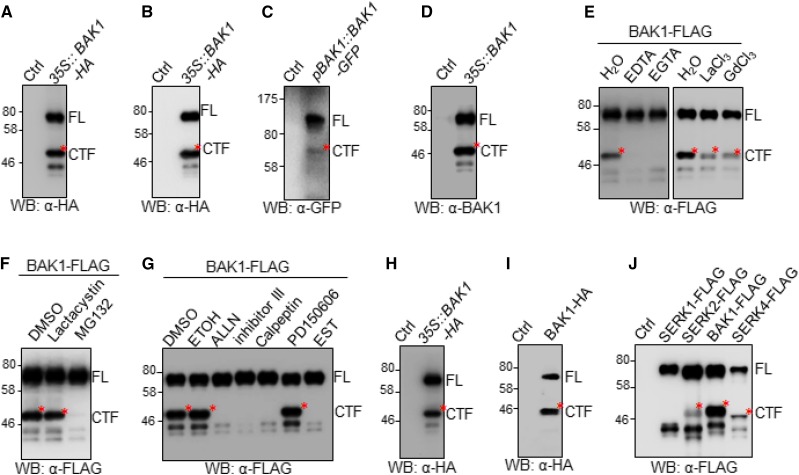Figure 1.
Proteolytic processing of BAK1 in plants by a conserved protease. A, Expression of BAK1-HA in Arabidopsis protoplasts. Protein extracts from Arabidopsis protoplasts transfected with 35S::BAK1-HA or a control vector (Ctrl) were analyzed by western blot (WB) with an α-HA antibody. The upper band corresponding to the FL BAK1 protein was indicated by FL, and the lower band corresponding to the CTF of BAK1 was indicated by CTF, and labeled with a red star. B and C, BAK1CTF is produced in Arabidopsis transgenic plants. Protein extracts from 35S::BAK1-HA (B) and pBAK1::BAK1-GFP (C) transgenic plants were analyzed by WB with respective α-HA and α-GFP antibodies. Wild-type Col-0 Arabidopsis was used as Ctrl. D, Nontagged BAK1CTF is produced in Arabidopsis protoplasts. Protein extracts from Arabidopsis protoplasts transfected with 35S::BAK1 were analyzed by WB with an α-BAK1 antibody. E and F, Effects of chemical inhibitors on the production of BAK1CTF. 1 mm of EDTA, 1 mm of EGTA, 1 mm of lanthanum chloride, 0.5 of mm gadolinium chloride, 2 μm of MG132, or 2 μm of Lactacystin was added immediately after protoplast transfection with 35S::BAK1-FLAG. Protein extracts were analyzed by WB with an α-FLAG antibody. Lactacystin and MG132 were stored in DMSO, and other chemicals were stored in H2O. G, Effects of Calpain inhibitors on the production of BAK1CTF. ALLN, Calpain inhibitor III, Calpeptin, PD150606, or EST (cat. no. 208733; Calbiochem) at a final concentration of 20 μm was added immediately after protoplast transfection with 35S::BAK1-FLAG. Protein extracts were analyzed by western blot with an α-FLAG antibody. EST was stored in ethanol (ETOH), and other inhibitors were stored in DMSO. H and I, BAK1CTF is produced in N. benthamiana and S. cerevisiae. Protein extracts from N. benthamiana transiently expressing 35S::BAK1-HA (H) and S. cerevisiae expressing pGAL1::BAK1-HA (I) were analyzed by WB with α-HA antibodies. J, Proteolytic cleavage is conserved in SERK family members. Protein extracts from Arabidopsis protoplasts expressing FLAG-tagged SERK1, SERK2, SERK3 (BAK1), or SERK4 were analyzed by western blot with α-FLAG antibodies. The above experiments were repeated three times with similar results.

